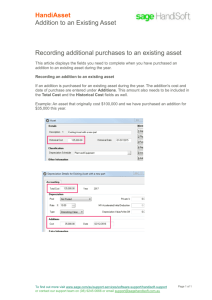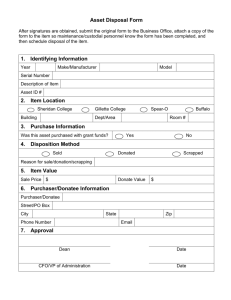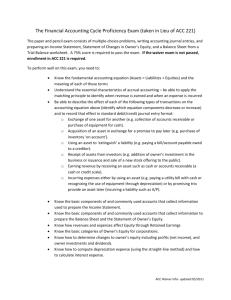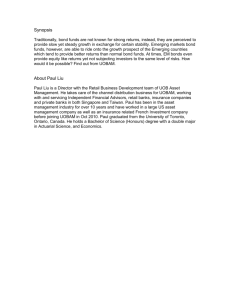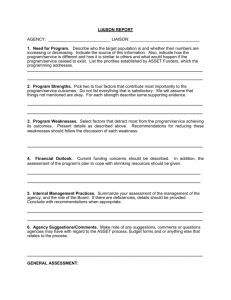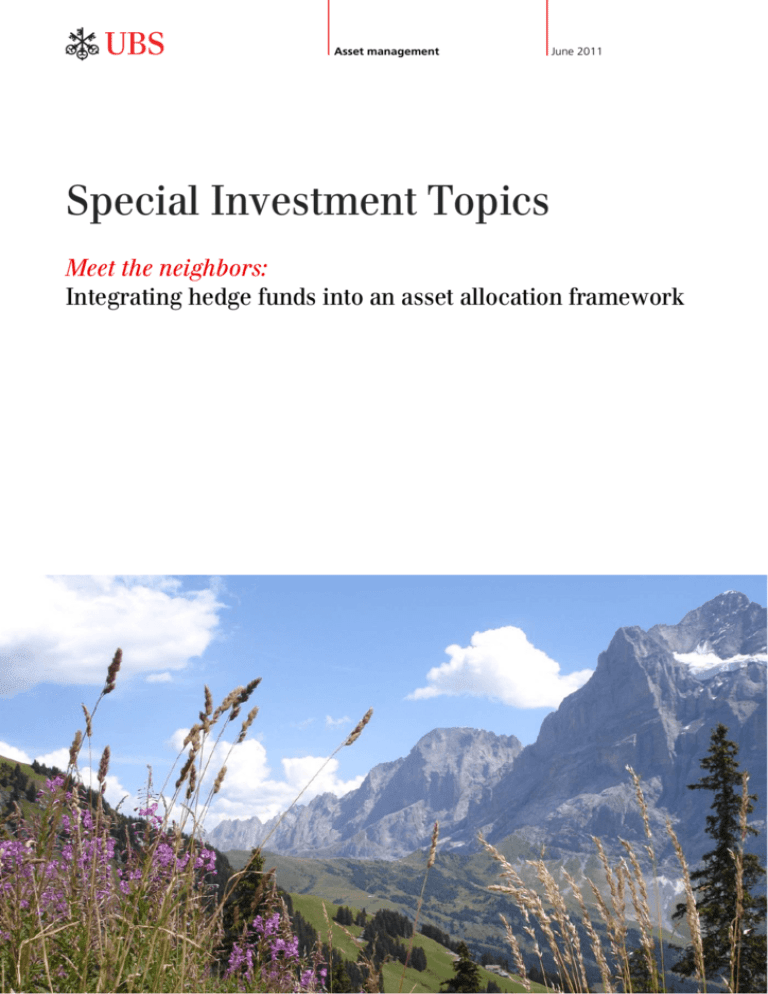
ab
Asset management
June 2011
Special Investment Topics
Meet the neighbors:
Integrating hedge funds into an asset allocation framework
Table of contents
Introduction.............................................................................................................................................................................. 3
Dimensions of asset allocation .................................................................................................................................................. 4
Developing an asset allocation grid ........................................................................................................................................... 4
Using the asset allocation grid – practical examples ................................................................................................................... 5
Conclusion ............................................................................................................................................................................... 6
Authors: ................................................................................................................................................................................... 7
Further Reading ........................................................................................................................................................................ 7
2
Introduction
Asset allocation is a bit like inviting people to a dinner party.
You have to try to find the right mix and ideally the people
should have different backgrounds – that reduces the risk of
boring discussions. Also, you can not fully rely on past
experience – it’s an indication, but no guarantee that the
same crowd will make a good party again. Similar
mechanisms work when you construct a portfolio.
Diversification, i.e. mixing different asset classes, is in general
a good thing. It should make you less vulnerable to single
events and should therefore stabilize your portfolio value. But
there is no guarantee that asset mixes that worked in the
past, will also work in the future. Correlation is an unreliable
friend, as we learned, especially in difficult times.
In practice, many asset allocators therefore
treat hedge funds as a separate asset class
with a separate risk budget and typically
allocate a relatively small part of their
allocation to it. In our experience this approach is often
chosen, not because allocators are particularly convinced
about it, but because “everyone” does it this way (including
most regulators) or because they lack a better alternative
concept. However, just to have no better alternative does not
necessarily mean that treating hedge funds as a separate
asset class is appropriate. In our view there are some
straightforward considerations that lead to a potentially better
approach. In essence hedge funds should not be viewed as a
separate asset class, but as an actively managed part of
“traditional” asset classes, such as equities, fixed income,
credit and commodities.
Exhibit 1:
Looking at hedge funds not as a separate asset class, but as
actively managed part of other (mainly liquid) asset classes
Asset allocation is therefore more an art than an exact
science. It’s in fact already difficult to find the right mix
between equities and bonds. When it comes to hedge funds,
many asset allocators find it even more difficult. Stretching
the above metaphor a bit further, hedge funds are a bit like
your new neighbors: You know that you should invite them
to your party, but you find it hard to judge how they will fit
in.
Fixed
Income
Equity
Real Assets
Hedge Funds
Private Equity
Commodity
Credit
Hedge Funds
Fixed
Income
Credit
Hedge
Funds
Equity
Real
Assets
Private Equity
Commodity
In the next few pages we want to lay out a simple and
practical asset allocation concept incorporating traditional
assets and hedge funds. We will provide an allocation grid
and examples how to use it for strategic as well as tactical
asset allocation decisions.
3
Exhibit 3:
Composition of different replicating portfolios
Equity hedge replication exposure
Alpha exposure
Equity - Developed
Equity - EM spread
Equity - Company size
Credit (five-year CDS)
Sovereign Bonds
Dimensions of asset allocation
Commodity
There are two generic dimensions to asset allocation. The
most obvious one relates to the allocation split between
different asset classes such as equity, fixed income, credit or
commodities. The decision can be extended to include
regions, sectors and currencies as well as other classifications.
Such a split allows steering the portfolio’s overall
characteristic as each asset class has its unique return drivers.
The second dimension is often introduced in the context of
risk budgeting. It defines how much of the risk should come
from market exposure and how much from active decisions.
Or to use financial terminology, it sets the allocation between
Beta risk and alpha risk exposure.
Our goal is to align hedge funds along these two dimensions
and thus integrate them into a practical asset allocation
concept. At first glance this might seem easy. Hedge funds
invest across all types of asset classes and have a high amount
of alpha risk. They can easily be fitted into an asset allocation
grid as shown in Exhibit 2. It is not so easy at second glance.
The challenge is that the hedge fund universe is very
heterogeneous. We need to be more granular and look at
single hedge fund types or strategies. But even single hedge
fund strategies can invest across different asset classes or be
exposed to alpha as well as beta risk, making a classification
less straightforward.
Currency basket
0%
Credit L/S replication exposure
Equity - Developed
Equity - EM spread
Equity - Company size
Credit (five-year CDS)
Sovereign Bonds
Commodity
Currency basket
0%
10%
20%
30%
40%
Equity Market Neutral replication exposure
Alpha exposure
Equity - Developed
Equity - EM spread
Equity - Company size
lpha
Commodity
Currency basket
Armed with this statistically derived information we can be
more granular when aligning hedge funds along the asset
class and alpha-beta dimension. The result is a much more
detailed asset allocation grid as shown in Exhibit 4. Hereafter
we use this grid to show how hedge funds can be
incorporated in typical asset allocation decisions.
Exhibit 4:
lpha
eta
Equity
ETF
Active
longonly
Credit
Index
Active
longonly
Fixed
Income
Index
Active
longonly
Index /
ETC
Active
longonly
Forward
Active
long
bias
Commodity
FX
Equity
hedged
Credit
L/S
Convert Arb
To help us with the classification, we apply a statistical trick.
For each hedge fund strategy or hedge fund product we ask
how the best replicating portfolio would look like if we could
only invest in traditional asset classes and in a hypothetical
alpha risk portfolio. Exhibit 3 shows the composition of the
replicating portfolios for three different hedge fund strategies.
The replicating portfolio for the equity hedge strategy is – not
surprisingly – dominated by equity exposure (exposures to
developed equity, emerging markets and company size). It
also includes small weights to commodity and currency, and
has a 20% allocation to “pure” alpha. The replicating
portfolio is derived from a statistical factor model based on
empirical data from 2000-2010. For more information, please
see “Further Reading” (page 6).
The composition of the replicating portfolio for credit long /
short and Equity market neutral strategies is very different,
with the latter being almost exclusively exposed to alpha.
Comdty
Macro
CTA
Equity
Mkt
Neutral
Credit
RV
Trading – CTA
Developing an asset allocation grid
10% 20% 30% 40%
Event
Driven
Source: UBS Global Asset Management, for illustrative purposes only
0%
Trading - Macro
FX
-10%
Asset Classes
Hedge fund
universe
Active longonly managers
Indexed products
Asset Classes
40%
Alpha exposure
Equity
Commodity
30%
Sovereign Bonds
eta
Fixed
Income
20%
Credit (five-year CDS)
Exhibit 2:
Credit
10%
FI Arbitrage
FX
GTAA
Source: UBS Global Asset Management, for illustrative purposes only
4
Using the asset allocation grid –
practical examples
Example 1: Risk budgeting or setting a strategic asset
allocation
Example 2: Negative equity outlook or risk-reducing trades
Exhibit 5:
Exhibit 6:
lpha
Commodity
FX
Second step
Second step
Second step
Source: UBS Global Asset Management, for illustrative purposes only
The asset allocation grid suggests a new two-step approach
when designing a portfolio and deciding on a strategic asset
allocation. The first step of this new approach consists of
allocating between (traditional) asset classes using established
methods such as risk-return projections and scenario analysis
as well as client expectation and constraints. Because hedge
funds are no longer considered a separate asset class, they are
not allocated an individual risk budget initially. Only allocating
to traditional asset classes at this stage allows defining what
generic risk drivers will affect the portfolio in the long term.
The second step addresses the alpha-beta dimension. Here
the question becomes: “How do we want to be exposed to
each asset class?” Or in other words, how do we want to be
exposed to the risks driving the performance of each asset
class? To what degree do we intend to take passive beta risk
versus active alpha risk?
To give an example, we assume that the first step resulted in
a 20% allocation to equities. As part of the second step, we
decide to split this 20% allocation and invest 5% in a purely
passive way, 10% through traditional long only or 130/30
mandates, and the remaining 5% allocation to high-alpha risk
exposure. Hence we can invest 5% into hedge fund strategies
such as equity hedged, trading, event driven or equity market
neutral. Just as a reminder, these are all hedge fund strategies
that are exposed to equity risk drivers in one way or another
and are thus aligned with the decision made in step one.
Fixed
Income
Commodity
FX
Trading (Macro / CTA)
Fixed
Income
Credit
Increase equity alpha
Low-yielding ccy
Second step
move to Comdty
Credit
Equities
move to FI
Second step
lpha
eta
Asset Classes
Equity
First step
Asset Classes
eta
Source: UBS Global Asset Management, for illustrative purposes only
High equity valuations, fading growth expectations at the end
of a business cycle, events triggering an increase in risk
aversion, or supply shocks are all reasons for wanting to
tactically reduce equity exposure and risk in general. Within
the asset allocation grid, this can be implemented by either
moving vertically out of equity into other asset classes or
horizontally away from beta to alpha exposure. A vertical
move out of equity will predominantly flow into fixed income
especially if valuations and growth concerns are at its origin.
Yet if this move is triggered by a spike in risk aversion or a
supply shock, allocations to commodity and anti-carry
currencies offer interesting tactical possibilities. Anti-carry
currencies are low-yielding, “safe heaven” currencies which
tend to appreciate during times of heightened global
uncertainties. A horizontal move toward alpha risk makes
most sense if tactical changes are expected to have a mid- or
longer-term horizon simply due to the liquidity aspect of
hedge fund products. A horizontal move must not restrain
itself to equity-based hedge fund strategies. Other hedge
fund strategies can be considered. Systematic trading
strategies (CTAs) for example can be very useful to diversify
equity risk.
For our purpose we have focused on liquid asset classes. For
the purpose of asset allocation, we consider hedge funds to
be liquid as long as they provide at least quarterly liquidity.
Real estate, infrastructure and private equity can be
integrated into this framework by introducing a third
dimension – liquidity. For additional information please see
“Further Reading”.
5
Example 3: Rising interest-rate outlook
Exhibit 7:
lpha
eta
Commodity
Increase alpha
move
Fixed
Income
move
Credit
move
Asset Classes
Equities
FX
Source: UBS Global Asset Management, for illustrative purposes only
A booming economy and inflation pressure can underpin
rising interest-rate expectations and the desire to move out of
fixed income and long credit positions. Translating this
situation into the asset allocation grid, we can again consider
the merit of vertical and horizontal adjustments. Commodity
prices should profit from a booming economy, and increasing
interest-rate differences between countries can create
opportunities in the FX space. If investors’ liquidity needs
permit, real assets such as infrastructure or real estate can be
considered. While rising interest rates do not support equity
prices in general, moving into selected equity sectors such as
consumer staples, telecoms or technology offers another
vertical possibility.
Horizontal moves open up new doors to address a scenario of
rising interest rates. A switch to credit and fixed incomerelated hedge fund strategies can be complemented with
more market neutral equity strategies or active commodity
products. The asset allocation grid offers a new approach to
think about ways to implement tactical views.
Conclusion
As initially stated, our goal was to provide a straightforward,
simple and practicable asset allocation concept embracing
hedge funds. We therefore introduced a two-dimensional
asset allocation grid and gave examples of potentially
beneficial horizontal and vertical shifts. This approach gives
investors more options to express not only their strategic, but
also their tactical views (like in the examples of falling equity
markets or rising interest rates).
The key difference to the models we typically see in practice is
that hedge funds are not treated as a separate asset class
with a separate risk budget. Instead, different hedge fund
strategies are seen as actively managed risk exposure within
the traditional asset classes they best fit into. Clearly this is
not an exact science, but looking at the explaining factors of a
replicating portfolio gives a fairly useful idea how to classify
the different hedge fund strategies.
Once this exercise has been completed and the asset
allocation grid finalized, the strategic and tactical changes
become increasingly clear. Under most scenarios, both vertical
and horizontal moves will be viable options. Ultimately this
should lead to a better asset mix. It’s like getting to know the
new neighbors before you send out the dinner invitations.
6
Authors:
Vincent Couson, CFA, CAIA
Wolfgang Batt, MBA
Head of Strategic Alternative Solutions
Hedge funds Product Specialist
Global Investment Solutions
Alternative and Quantitative Investments
UBS Global Asset Management
UBS Global Asset Management
vincent.couson@ubs.com
wolfgang.batt@ubs.com
Further Reading
To request the following publications, please contact vincent.couson@ubs.com.
Adding private equity to a portfolio – Understanding liquidity risk implications and how they affect the choice of a target
allocation, Vincent Couson, UBS Global Asset Management white paper, 2010
Hedge fund risk modeling – Linking hedge funds to traditional asset risk, Vincent Couson and Sa Lu, UBS Global Asset
Management white paper, 2010
7
The views expressed are as of May 2011 and are a general guide to the views of UBS Global Asset Management. This document does not replace portfolio and fund-specific
materials. Commentary is at a macro or strategy level and is not with reference to any registered or other mutual fund. This document is intended for limited distribution to
institutional clients, consultants and associates of UBS Global Asset Management. Use or distribution by any other person is prohibited. Copying any part of this publication
without the written permission of UBS Global Asset Management is prohibited. Care has been taken to ensure the accuracy of its content but no responsibility is accepted for
any errors or omissions herein. Please note that past performance is not a guide to the future. Potential for profit is accompanied by the possibility of loss. The value of
investments and the income from them may go down as well as up and investors may not get back the original amount invested. This document is a marketing communication.
Any market or investment views expressed are not intended to be investment research. The document has not been prepared in line with the requirements of any jurisdiction
designed to promote the independence of investment research and is not subject to any prohibition on dealing ahead of the dissemination of investment research. The
information contained in this document does not constitute a distribution, nor should it be considered a recommendation to purchase or sell any particular security or fund. The
information and opinions contained in this document have been compiled or arrived at based upon information obtained from sources believed to be reliable and in good faith.
All such information and opinions are subject to change without notice. A number of the comments in this document are based on current expectations and are considered
“forward-looking statements”. Actual future results, however, may prove to be different from expectations. The opinions expressed are a reflection of UBS Global Asset
Management’s best judgment at the time this document is compiled and any obligation to update or alter forward-looking statements as a result of new information, future
events, or otherwise is disclaimed. Furthermore, these views are not intended to predict or guarantee the future performance of any individual security, asset class, markets
generally, nor are they intended to predict the future performance of any UBS Global Asset Management account, portfolio or fund.
© UBS 2011. The key symbol and UBS are among the registered and unregistered trademarks of UBS. All rights reserved.
ab
8



